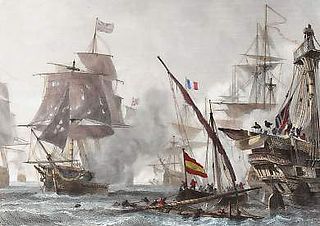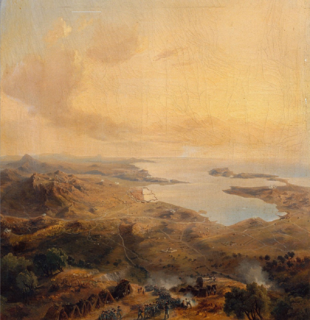 W
WThe Algeciras campaign, or Battles of Algeciras, was a brief naval campaign fought between a combined French and Spanish Navy force and a British Royal Navy force during 4–13 July 1801. A French squadron, seeking to join the Spanish fleet and a number of French ships of the line at the Spanish Atlantic base of Cadiz, sailed from Toulon on 13 June under Contre-amiral Charles Linois. Rounding the British naval base of Gibraltar on the southern coast of Spain on 4 July, Linois learned that a British squadron under Rear-Admiral Sir James Saumarez was on station off Cadiz. Seeking to avoid battle with Saumarez's much larger force, Linois anchored in the Spanish port of Algeciras, close to Gibraltar. Saumarez discovered Linois there on 6 July and attacked at 08:30, his ships hampered by light winds and Linois's strong defensive position.
 W
WThe Armée d'Orient was the French military force gathered by the French Directory to send on the expedition to Egypt in 1798. The expedition had the intention of barring Great Britain's route to its colonies in India and was put under the command of Napoleon Bonaparte.
 W
WThe Army of the Danube was a field army of the French First Republic. Originally named the Army of Observation, it was expanded with elements of the Army of Mainz (Mayence) and the Army of Helvetia (Switzerland). The army had three divisions plus an advance guard, a reserve, and an artillery park. The artillery park was under the command of Jean Ambroise Baston de Lariboisière and consisted of 33 cannons and 19 howitzers operated by 1,329 non-commissioned officers and cannoneers as well as 60 officers. There were approximately 25,000 members of the Army, the role of which was to invade southwestern Germany, precipitating the War of the Second Coalition.
 W
WThe Battle of Cape St. Vincent was one of the opening battles of the Anglo-Spanish War (1796–1808), as part of the French Revolutionary Wars, where a British fleet under Admiral Sir John Jervis defeated a larger Spanish fleet under Admiral Don José de Córdoba y Ramos near Cape St. Vincent, Portugal.
 W
WThe Biscay campaign of June 1795 consisted of a series of manoeuvres and two battles fought between the British Channel Fleet and the French Atlantic Fleet off the Southern coast of Brittany in the Bay of Biscay during the French Revolutionary Wars. In late May 1795, a British battle squadron of six ships of the line under Vice-Admiral William Cornwallis was sent by Admiral Lord Bridport to enforce the blockade of the French port of Brest, the home port of the French Atlantic Fleet. On 8 June, Cornwallis discovered a convoy of merchant vessels travelling from Bordeaux to Brest under the protection of a small squadron under Contre-amiral Jean Gaspard Vence. Cornwallis attacked the convoy, Vence retreating under the protection of batteries on the fortified island of Belle Île as Cornwallis seized eight ships from the convoy. As Cornwallis sent his prizes back to Britain the main French fleet at Brest under Vice-amiral Villaret de Joyeuse put to sea to protect Vence's remaining ships.
 W
WThe Battle of Camperdown was an important naval action of the French Revolutionary Wars, fought off Camperduin on the North Holland coast on 11 October 1797 between a British fleet under Admiral Adam Duncan and a Dutch fleet under Vice-Admiral Jan de Winter. The French Republic had overrun the Dutch Republic two years earlier, reforming it into the Batavian Republic. In early 1797, the Batavian Navy was ordered to sail to Brest and unite with the French Atlantic Fleet in preparation for an invasion of Ireland. Shortly afterwards, the British fleets were paralysed by the Spithead and Nore mutinies, in which the sailors refused to take their ships to sea until they were awarded better pay and conditions. For two months, the English Channel was undefended, but the Dutch failed to take the opportunity to sail from their harbour in the Texel: their preparations were not complete, and a small squadron of loyal British ships under Duncan convinced de Winter that the British fleet was at sea by sending nonsensical signals to fictitious ships over the horizon.
 W
WIn the Battle of Castiglione on 5 August 1796, the French Army of Italy under the command of General Napoleon Bonaparte defeated an Austrian army led by Field Marshal Dagobert Sigmund von Wurmser. Castiglione and the Battle of Lonato were the major actions in a campaign which marked the first attempted relief of the Siege of Mantua. While Wurmser advanced east of Lake Garda with three columns, Peter Quasdanovich moved his column into the area west of Lake Garda. The Austrians pushed back the French forces and forced Bonaparte to raise the siege. However, the French commander massed against Quasdanovich and forced him to retreat after a week of see-saw fighting. After disposing of Quasdanovich, Bonaparte turned on Wurmser and defeated the main army also. In the sequel, the French pushed the Mantua garrison back and blockaded the city.
 W
WThe Croisière de Bruix was a naval campaign of the French Revolutionary Wars. Planned and commanded by French Vice-Admiral Étienne Eustache Bruix, the operation was an attempt to restore French control of the Mediterranean Sea, lost at the Battle of the Nile in August 1798. Taking command of the French Atlantic Fleet based at Brest, Bruix mustered one of the largest and best trained French fleets to take to sea during the war. Brest was under close blockade by the British Channel Fleet, but Bruix arranged for misleading intelligence regarding an impending invasion of Ireland to fall into British hands, which drew the blockade fleet under Lord Bridport away to the north. On 25 April 1799 the French fleet of 25 ships of the line sailed into the Atlantic unopposed, sighted the following day by the frigate HMS Nymphe. Reports reached Bridport soon afterwards, but he remained on station off Ireland, anticipating a French attack.
 W
WThe Expédition d'Irlande was a French attempt to invade Ireland in December 1796 during the French Revolutionary Wars. Encouraged by representatives of the Society of United Irishmen, an Irish republican organisation, the French Directory decided that the best strategy for eliminating Britain from the war was to invade Ireland, then under British control. It was hoped that a substantial invasion in the summer of 1796 would encourage a widespread uprising among the Irish population and force the British to abandon Ireland, providing a major strategic and propaganda coup for the French Republic and a staging point for a subsequent invasion of Britain. Assigned to lead the operation was General Lazare Hoche, the Republic's most successful military commander, who was provided with a significant body of troops and the services of the entire French Atlantic fleet.[A]
 W
WThe Order of battle at the Battle of Genoa recounts the British-Neapolitan and French fleets which participated in a short campaign in the Gulf of Genoa during the French Revolutionary Wars. The campaign featured the principal Battle of Genoa on 13–14 March 1795, and an earlier smaller battle off Cap Corse on 8 March. Losses were even: although the British succeeded in capturing two French ships in the main action, two British ships were also lost elsewhere during the campaign. The French foray into the Ligurian Sea was driven back to a safe harbour, resulting in a restoration of the British blockade of Toulon, and leading to a second battle later in the year.
 W
WIn the Battle of Hohenlinden on 3 December 1800, a French army commanded by Jean Victor Marie Moreau decisively defeated the army of Habsburg Monarchy led by Archduke John. The first action of the campaign was the Battle of Ampfing, two days earlier. After Hohenlinden there was a series of rearguard clashes beginning on 9 December at Rosenheim and continuing from the 14th through the 20th at Salzburg, Neumarkt am Wallersee, Frankenmarkt, Schwanenstadt, Vöcklabruck, Lambach, and Kremsmünster. During the retreat, the Habsburg army began a process of disintegration and an armistice was concluded a few days later.
 W
WMartin's cruise of 1794 was the only significant French naval operation of the year in the Mediterranean Sea. In 1793 France had gone to war with Great Britain and a wide coalition of European enemies in the French Revolutionary Wars. Early in the conflict the British had seized the French Mediterranean Fleet and their home port of Toulon, the town enduring a four month siege by French Republican forces in which the fleet was badly damaged. With the town and fleet back in French hands, the French set about effecting repairs as the British attacked the island of Corsica.
 W
WIn the Montenotte campaign between 10 and 28 April 1796, General Napoleon Bonaparte's French Army of Italy broke the link between Feldzeugmeister Johann Peter Beaulieu's Austrian army and Feldmarschallleutnant Michelangelo Alessandro Colli-Marchi's Sardinian army. In subsequent engagements, the French defeated the Austrians, pursued Colli to the west, and forced the Sardinians to withdraw from the First Coalition against France. Actions were fought at Voltri on 10 April, Monte Negino (Legino) on 11 April, Montenotte on 12 April, Millesimo on 13 April, Second Battle of Dego on 14–15 April, Ceva on 16 April, San Michele Mondovi on 19 April, and Mondovì on 21 April.
 W
WThe Glorious First of June of 1794 was the first and largest naval action between the French and British fleets during the French Revolutionary Wars. The action was fought over 400 miles (640 km) west of Ushant, the most western point on Brittany in France, deep in the Atlantic Ocean. The British fleet under Lord Howe was attempting to defeat a French fleet under Villaret de Joyeuse which was in turn attempting to lure Howe away from a grain convoy destined for France from the United States. The future of the French Revolution depended on this 117-strong convoy which would save France from famine if it arrived safely. Ultimately, both admirals were successful in their ambitions; Howe defeated Villaret in open battle and sunk or captured seven of his ships. Villaret managed to occupy Howe for long enough and inflict sufficient damage that the convoy escaped unscathed.
 W
WOn 25 March 1799, French and Habsburg armies fought for control of the geographically strategic Hegau in present-day Baden-Württemberg. The battle has been called by various names: First Battle of Stockach, the Battle by Stockach, and, in French chronicles, the Battle of Liptingen.
 W
WThe Battle of the Nile was a significant naval action fought during 1–3 August 1798. The battle took place in Aboukir Bay, near the mouth of the River Nile on the Mediterranean coast of Egypt and pitted a British fleet of the Royal Navy against a fleet of the French Navy. The battle was the climax of a three-month campaign in the Mediterranean during which a huge French convoy under General Napoleon Bonaparte had sailed from Toulon to Alexandria via Malta. Despite close pursuit by a British fleet of thirteen ships of the line, one fourth rate and a sloop under Sir Horatio Nelson, the French were able to reach Alexandria unscathed and successfully land an army, which Bonaparte led inland. The fleet that had escorted the convoy, consisting of thirteen ships of the line, four frigates and a number of smaller vessels under Vice-amiral François-Paul Brueys D'Aigalliers, anchored in Aboukir Bay as Alexandria harbour was too narrow, forming a line of battle that was protected by shoals to the north and west.
 W
WThe Battle of Tory Island was a naval action fought on 12 October 1798 off the north coast of Ireland. The battle contested an attempted French invasion of Donegal in support of the Irish Rebellion of 1798, with a French squadron under Jean-Baptiste-François Bompart facing a hastily assembled Royal Navy blockade squadron under Sir John Borlase Warren. Bompart's force had been dispatched from Brest the month before with orders to reinforce a French army under Jean Humbert which had landed two months earlier.
 W
WThe fate of the French fleet at the Siege of Toulon marked one of the earliest significant operations by the British Royal Navy during the French Revolutionary Wars. In August 1793, five months after the National Convention declared war on Great Britain, thus drawing Britain into the ongoing War of the First Coalition, the government of the French Mediterranean city of Toulon rose up against the Republican national government in favour of the Royalist faction. Toulon was the principal French naval port on the Mediterranean and almost the entirety of the French Mediterranean Fleet was anchored in the harbour. After negotiations the British commander in the Mediterranean, Admiral Lord Hood, the city's Royalists seized control and British forces, alongside allies from Spain, Naples and Sardinia entered the city, seizing the fleet and preparing defences against the inevitable Republican counterattack.